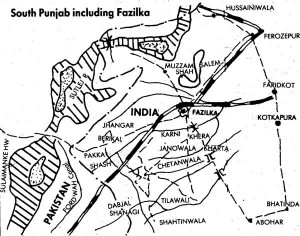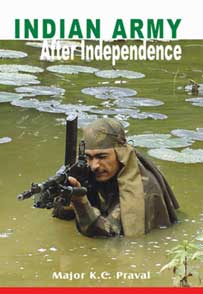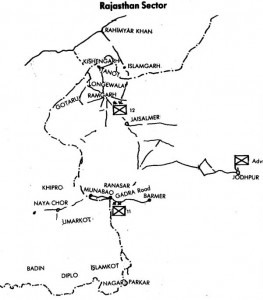 4 Jat was able to clear only a portion of the distributary and the bridge remained in enemy hands. During the night, many of the BSF posts fell or were withdrawn. The same was the fate of the remaining strongpoints held by 3 Assam and by first light, most of the battalion had withdrawn towards the distributary after suffering casualties. Less than half a dozen posts West of the distributary remained in Indian hands. Perhaps the most unfortunate happening was the blowing-up, in the early hours of 4 December of more than 20 bridges on the distributary and the creek from which it took off.Another counter-attack against the Beriwala lodgement was launched by 4 Jat during the night of 4/5 December but it achieved only partial success. The foothold was strengthened the next day and a third counter-attack was put in during the night of 5/6 December by the same battalion. In a determined bid, the forward elements reached the objective but in the ensuing hand-to-hand fighting, the company commander was killed. Some of the troops held on to a portion of the objective while the rest fell back. 4 Jat lost more than 60 men in this action.
4 Jat was able to clear only a portion of the distributary and the bridge remained in enemy hands. During the night, many of the BSF posts fell or were withdrawn. The same was the fate of the remaining strongpoints held by 3 Assam and by first light, most of the battalion had withdrawn towards the distributary after suffering casualties. Less than half a dozen posts West of the distributary remained in Indian hands. Perhaps the most unfortunate happening was the blowing-up, in the early hours of 4 December of more than 20 bridges on the distributary and the creek from which it took off.Another counter-attack against the Beriwala lodgement was launched by 4 Jat during the night of 4/5 December but it achieved only partial success. The foothold was strengthened the next day and a third counter-attack was put in during the night of 5/6 December by the same battalion. In a determined bid, the forward elements reached the objective but in the ensuing hand-to-hand fighting, the company commander was killed. Some of the troops held on to a portion of the objective while the rest fell back. 4 Jat lost more than 60 men in this action.
At this stage, Ram Singh took charge of the battle. He reinforced the brigade with infantry and artillery and also replaced one armour squadron as casualties and bogging had reduced its strength to a troop. Then, on the night of 8/9 December he ordered another counter-attack by 15 Rajput and a squadron of tanks to retake Beriwala. However, the Pakistanis were by this time well entrenched and threw back the attack. Ram Singh was wounded, but retained command.
Ram Singh took charge of the battle. He reinforced the brigade with infantry and artillery and also replaced one armour squadron as casualties and bogging had reduced its strength to a troop.
Repeated failures led to Chowdhary’s replacement by Brigadier Piara Singh on 11 December. Meanwhile, the enemy had become more aggressive. It attacked a position on the outskirts of Fazilka held by 3/11 Gorkha Rifles, a newly inducted unit. Piara Singh did his best to restore the situation but the destruction of the bridges over the distributary left little chance for manoeuvre. Two of the posts were recaptured on the night of 11/12 December but another counter-attack against Beriwala, put in two nights later, failed. Despite Piara Singh’s efforts the overall situation remained unchanged till the cease-fire. The brigade’s casualties during the 14 days of fighting were 811: 190 killed, 425 wounded and 196 missing.11
The rest of ‘F’ Sector did not see any noteworthy action, except for 51 Independent Parachute Brigade, led by Brigadier E.A. Thyagaraj. This formation was holding an 80 kilometre stretch of the border in the Ganganagar area. Except for three raids across the border to capture prisoners for identification, the area basically remained quiet. It was after the cease-fire that the Pakistanis provoked the paratroopers.
At Jalwala, 1,500 metres from the border. Pakistan’s Eastern Sadiqia Canal forks into three branches. The enemy had a defensive position and a squadron of armour to protect the headworks. India had a BSF post facing the headworks, about a kilometre from the boundary. On 25 December, it was discovered that the Pakistanis had crossed the border and established themselves on a couple of sand-dunes facing the BSF.
A reconnaissance ascertained that regular Pakistani troops had entrenched themselves on the encroachment with anti-tank and anti-personnel mines. As a consequence, Thyagaraj ordered 4 Para to push them out of Indian territory. A company-attack was put in in the early hours of 28 December and the mission was accomplished after a battle that lasted two hours. Though the enemy had only a platoon of its 36 Frontier Force and some Rangers on the encroachment, its artillery played havoc with the assault company and two other companies that had moved forward. It is estimated that the Pakistanis employed 72 artillery pieces in this action. Indian casualties, including those suffered by 9 (Para) Field Regiment, totalled 81: 21 killed (including three officers) and 60 wounded (including two officers). Three of the enemy were captured. However, enemy casualties could not be ascertained as the Pakistanis removed their dead and wounded when they withdrew.
The Barmer sector was under 11 Infantry Division under Major General R.D.R. Anand. The Division had its Headquarters at Ranasar, about 11 kilometres short of the border at Gadra Road.
Some of the fiercest battles of this war were fought by the troops of Western Command. Both sides suffered heavy casualties, Indian casualties totalling 6,524. Of these, 1,628 were killed, 4,131 wounded and 253 missing while 512 were prisoners of war. Pakistan did not announce its casualties. These would, in all probability, have been as heavy.
Once again, formation and higher level command in 11 Corps zone had failed. At Fazilka, the corps commander issued preliminary orders for a portion of ‘F’ Sector to fall back on the Gang Canal, well to the East of the defensive line. This order had to be countermanded by GOC-in-C Western Command. The arrival of Headquarters 2 Corps in the West with 9 Division and 50 (Para) Brigade did provide relief in some measure but it was too late to undo the adverse situations created by 11 Corps’ command structure.
Rajasthan
For operational purposes, the border under Southern Command was divided into four sectors. From North to South, these were Bikaner, Jaisalmer, Barmer and Kutch. The 1971 campaign was, however, largely confined to the Jaisalmer and Barmer sectors due to the poor surface communications in the other two. The Jaisalmer sector was under 12 Infantry Division, commanded by Major General Khambata. The Divisional Headquarters was at Tanot, about 120 kilometres North of Jaisalmer. The Barmer sector was under 11 Infantry Division under Major General R.D.R. Anand. The Division had its Headquarters at Ranasar, about 11 kilometres short of the border at Gadra Road. The divisional centre lines were about 240 kilometres apart in these two sectors. There was no corps Headquarters controlling the forces here. Command was to be assumed by an advanced Headquarters of Southern Command.
| Editor’s Pick |
North of Tanot and parallel to the border, ran Pakistan’s main railway and road system connecting Karachi, her only seaport in West Pakistan, with Lahore. Rahimyar Khan, about 65 kilometres from the border, was an important station, of this railway. The Indian plan was to cut off Karachi from Lahore by capturing Rahimyar Khan with 12 Division. At the same time, 11 Division was to advance to the Naya Chor—Umarkot area and pose a threat to Hyderabad (Sind) (see Fig. 14.5). Before partition, the metre-gauge railway connecting Barmer to Gadra Road and Munabao used to run right up to Hyderabad. Partition had given Gadra Road and Munabao to India but Gadra City went to Pakistan, as also the railway beyond Munabao. The Pakistani authorities had removed a portion of the track near the border and ran their train services only up to Khokhropar, a village about six kilometres form Munabao. Southern Command planned to revive the rail-link between Munabao and Khokhropar and use the line for operational purposes.
Lieutenant General G.G. Bewoor, GOC-in-C, set up his Advanced Headquarters at Jodhpur and divided between the two divisions the combat manpower and equipment at his disposal. The reserves with him comprised one infantry battalion and a squadron of anti-tank guided missiles.12 These could hardly be expected to influence an advance on two widely separated axes.
This was the first time that the Indian Army was to undertake fairly large-scale operations in the desert. From the course of events it would appear that the planners of the campaign did not pay adequate attention to the problems of movement and maintenance in the terrain in which the troops were to operate. They were apparently guided by the experience of campaigns in the Western Desert of North Africa, where many Indian divisions fought the Axis armies during the Second World War. The Thar and Kutch Deserts are, however, quite different from the African one.
 The latter allows free movement of wheeled traffic over most of the coastal region and Allied armies could move cross-country on wide fronts. The soft sand of the Thar Desert does not generally permit the movement of wheeled traffic off the road. Though sand tyres were issued to combat formations these soon wore off and replacements were not forthcoming. Provision had been made for laying duckboard tracks but the material available to the two divisions was insufficient for their tasks. Water was another big problem.Plastic containers and Braithwaite tanks were given to units but the carriage of water to forward areas became difficult due to the shortage of bowsers. Besides the inadequacy of engineer resources, a big handicap for Indian commanders was the lack of accurate intelligence regarding the state of communications across the border.
The latter allows free movement of wheeled traffic over most of the coastal region and Allied armies could move cross-country on wide fronts. The soft sand of the Thar Desert does not generally permit the movement of wheeled traffic off the road. Though sand tyres were issued to combat formations these soon wore off and replacements were not forthcoming. Provision had been made for laying duckboard tracks but the material available to the two divisions was insufficient for their tasks. Water was another big problem.Plastic containers and Braithwaite tanks were given to units but the carriage of water to forward areas became difficult due to the shortage of bowsers. Besides the inadequacy of engineer resources, a big handicap for Indian commanders was the lack of accurate intelligence regarding the state of communications across the border.
Click to buy: Indian Army After Independence
 Khambata had under him three Infantry brigades, his divisional artillery brigade, 20 Lancers (AMX-13), 3 Independent Armoured Squadron (T -55), and an engineer regiment. At the outbreak of hostilities, one of the infantry brigades held the firm base in the general area Kishengarh-Tanot-Sadhewal-Longewala. The assault brigade was concentrated near Mokal and the follow-up brigade was held in the Sanu area.
Khambata had under him three Infantry brigades, his divisional artillery brigade, 20 Lancers (AMX-13), 3 Independent Armoured Squadron (T -55), and an engineer regiment. At the outbreak of hostilities, one of the infantry brigades held the firm base in the general area Kishengarh-Tanot-Sadhewal-Longewala. The assault brigade was concentrated near Mokal and the follow-up brigade was held in the Sanu area.
Pakistan’s 51 Infantry Brigade, from their 18 Infantry Division, was deployed in the Rahimyar Khan area while their border posts were held by paramilitary personnel. According to Indian intelligence, an armoured regiment equipped with Shermans was in support of this brigade but the enemy was actually able to launch a composite regiment comprising two squadrons of T-59 and one of Shermans (22 Cavalry). Rahimyar Khan itself lay in a canal-irrigated region but to its South, right up to the border, was sandy desert. Pakistan had developed no roads beyond the canal area and the sand belt served as a deterrent to attack.
Southern Command’s offensive was scheduled to start on the night of 4 December. However, due to the lack of preparation in the Jaisalmer sector, 12 Division’s mission was postponed for 24 hours, though preliminary moves had begun earlier. The postponement, in fact, saved Khambata from a good deal of embarrassment.
During the night of 4 December forward elements of 12 Division captured a border post on its route of advance. Operations were also in progress for the capture of Islamgarh, another post on the same axis. Air reconnaissance had earlier been carried out on the evening of 4 December and no enemy activity was noticed on the Islamgarh-Rahimyar Khan route. The reconnaissance did not, however, cover the Gabbar-Longewala axis. Apparently, Khambata expected no enemy initiative from that direction.
Southern Commands offensive was scheduled to start on the night of 4 December. However, due to the lack of preparation in the Jaisalmer sector, 12 Divisions mission was postponed for 24 hours, though preliminary moves had begun earlier.
Islamgarh was captured around 0400 hours on 5 December. Two hours earlier, a patrol from the Indian locality at Longewala, manned by a company from 23 Punjab, had reported the approach of an enemy armoured column. 16 kilometres inside Indian territory, this isolated locality had no anti-tank weapons or mines. The battalion commander rushed two recoilless guns to the locality and informed the brigade and divisional commanders of the developments.
Khambata alerted the air-base at Jaisalmer and asked for a strike at first light. Meanwhile, it fell to Major Kuldip Singh Chandpuri, the company commander at Longewala, to hold out till the arrival of air-support and reinforcements. It was a moonlit night and his men could soon see the Pakistani T-59s and the infantry that accompanied them on jeeps take up positions on a ridge about 300 metres away. His machine-gunners and the crews of the newly received recoilless guns engaged at very high rates of fire. From its volume, the Pakistanis assumed that Longewala was strongly held and decided to encircle the locality instead of storming it. They kept engaging it with fire. It is possible that a strand of barbed wire that ran around the locality to keep stray dogs out gave them the impression that it was a protective minefield marker.





Surprising to see that the role of 2nd Bn BSF is completely ignored in the narration. This battalion had established bridgehead across the salt flats of Suigam sector and had attacked and overrun the towns of Virawah and Nagar Parkar. Assistant Commandant T. P. Singh was awarded Sena Medal and the commandant, Lt Col L B Kane was awarded VSM for these crucial battles, establish firmbase from which 10 Para conducted further ops.